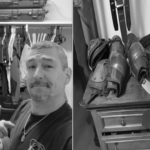
San Bernardino County has a fascinating history and for anyone with a strong interest in our region’s first century, nobody told it better than the dynamic husband and wife duo of George and Helen Beattie.
A native of Jamaica, West Indies, George William Beattie was born on April 10, 1859. He grew up in Oberlin, Ohio, and arrived in California’s San Bernardino Valley with his mother, Angelica, and sister Laura at the age of 15 in 1874. The boy’s father died before his birth.
Called an “uncommon man” by his daughter-in-law, the late author and historian Kathryn “Kay” Beattie in her book “GEORGE WILLIAM BEATTIE An Uncommon Man: His Life and Times 1859-1949,” “Will” — as he was best known — matched that description.
Starting out teaching school in Lugonia, part of today’s north Redlands area, in 1877 at age 18, he moved to East Highlands in 1881. He worked as a clerk for the San Bernardino County Board of Supervisors from 1887-1889, resigning when he was appointed County treasurer, and then served as San Bernardino County Superintendent of Schools for four years beginning in 1890.
Will helped form the North Fork Water Company in Highland and also established Pomona College, which opened in 1887.
In 1901, Will obtained a master’s degree in chemistry at UC Berkeley and on July 29 of that year, married Owensville, Indiana, native Helen Gertrude “Nellie” Pruitt. Pruitt was teaching at Laurel School in Lytle Creek and accepted the position as Division Superintendent of Schools on the island of Negros in the Philippines.
A week after marriage they sailed for the Southeast Asian country where they would spend the next 10 years. Helen gave birth to three children during that time. One child died before it was a year old. The other two are Helen and George Frederick.
Will’s last work in the Philippines was as dean of the College of Letters and Science at the University of the Philippines in Manila which he helped to found.
Following their return to California in 1911 and settling in East Highlands as citrus ranchers, Will became a member of the Board of Freeholders while also serving as president of the East Highlands Citrus Association.
The Beatties also developed a passionate interest in historical research of California, especially pertaining to San Bernardino County. And this is where their legacy is best remembered.

Will’s interest in history began while as a boy becoming concerned with the decaying ruins of the old San Bernardino Asistencia, on Barton Road in Redlands. According to his daughter-in-law, Kay Beattie, he and his family would drive by the ruins to pick up the mail. That specific interest manifested itself many years later when he played a major role in the restoration of the site during the 1930s.
Among Will Beattie’s research-based literary contributions were “California’s Unbuilt Missions,” published in 1930 and “Origin and Early Development of Water Rights in the East San Bernardino Valley,” which was published in 1951 — two years after he died.
Meanwhile, Helen Beattie completed her university courses, receiving a degree from the University of Redlands and a master’s degree from that school at age 60 in 1936.
She was a member of the Daughters of the American Revolution, served for two years as state chairperson of the California History and Landmarks Committee of the State Federation of Women’s Clubs, was a member of the Cram School Board of East Highlands from 1917 to 1927, and was an active member of the San Bernardino County Historical Society. She also gave many speeches on California History.
But it is for their historical research and the publication of “Heritage of the Valley: San Bernardino’s First Century” published in 1939 — perhaps the most outstanding history of San Bernardino County — that the Beatties are best known.
In creating this illuminating volume, which covers the colorful story of San Bernardino County’s first century, the tireless couple gleaned previously unpublished and long forgotten data. The result was and still is a well-written, chronological masterpiece.
This meticulously researched 459-page history of the Inland Empire extends from the Indigenous tribes through the first explorations of the Spanish missionaries, the Mexican ranchos, Mormon settlers, gold-seekers, lumbermen and outlaws, the Civil War period and ending in 1870. It also touches on the region’s role as a crossroads of trade with the Los Angeles and San Diego areas. The story extends through the Civil War, which was a major part of Helen Beattie’s master’s thesis.
The Beatties read through hundreds of manuscripts, letters and records. They searched the original documents in the library of the Mormon Church in Salt Lake City. Helen translated many Spanish documents.
The Beatties are long gone now, George William died on May 16, 1949 in San Bernardino at the age of 90 and Helen Pruitt passed away at 80 on March 11, 1956, but their legacy lives on.
Contact Nick Cataldo at Yankeenut15@gmail.com and read more of his local history articles at Facebook.com/BackRoadsPress.





